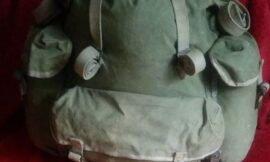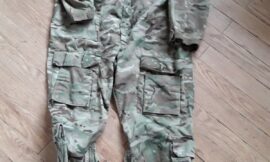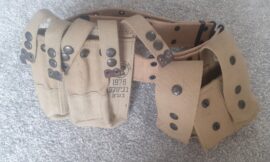The FN FAL (Fusil Automatique Léger), often referred to as “The Right Arm of the Free World,” is one of the most iconic and widely used battle rifles of the 20th century. Designed by the Belgian company Fabrique Nationale de Herstal (FN), the FAL has seen service in numerous conflicts around the globe and remains in use in various capacities today.
Historical Background
The development of the FN FAL began shortly after World War II. In the late 1940s, FN began work on a new rifle to replace the bolt-action rifles that had dominated the first half of the century. By 1953, the FAL was ready for mass production and quickly garnered attention for its reliability, accuracy, and powerful cartridge.
The FAL was chambered in 7.62×51mm NATO, a standardized round adopted by NATO in the 1950s, ensuring interoperability among allied forces. This helped the FAL become one of the most widely distributed rifles among NATO and other Western-aligned countries during the Cold War.
Design and Features
The FN FAL’s design incorporates several key features that contribute to its effectiveness as a battle rifle:
- Gas-Operated Mechanism: The FAL uses a gas-operated action with a short-stroke piston, providing reliable cycling of the bolt and reducing recoil.
- Adjustable Gas System: One of the FAL’s distinctive features is its adjustable gas system, allowing the user to regulate the amount of gas used to cycle the action. This adaptability improves reliability under various conditions and with different ammunition.
- 7.62×51mm NATO Cartridge: The rifle’s powerful cartridge offers excellent range, stopping power, and penetration, suitable for battlefield engagements.
- Selective Fire: Many FAL models have selective fire capabilities, allowing the shooter to switch between semi-automatic and fully automatic modes. However, the high recoil in full-auto mode led many armies to limit the use of full-auto fire.
- Ergonomics: The FAL is designed with user comfort in mind, featuring a pistol grip, a relatively light weight for its class (around 9-11 pounds), and a well-balanced design.
- Robust Construction: Built from high-quality materials, the FAL is known for its durability and reliability in harsh conditions.
Variants
Several variants of the FN FAL have been produced to meet different operational requirements:
- FAL 50.00: The standard model with a fixed stock.
- FAL 50.41 and 50.42: Heavy-barrel versions designed for use as squad automatic weapons, featuring bipods and other modifications.
- FAL 50.63: Also known as the “Para FAL,” this model has a folding stock and a shorter barrel, designed for paratroopers and other airborne forces.
- L1A1: A variant produced under license in the UK and used by British and Commonwealth forces. It features a semi-automatic-only configuration and different sight and furniture designs.
- C1 and C2: Canadian variants of the FAL, with the C1 being a semi-automatic infantry rifle and the C2 a heavy-barrel automatic rifle.
Military Use
The FN FAL has been used by over 90 countries, making it one of the most widely distributed rifles in history. Its service history includes numerous conflicts:
- Cold War: The FAL was adopted by many NATO countries and allied nations, serving as a frontline rifle throughout the Cold War.
- Falklands War: Both British and Argentine forces used the FAL during the Falklands War, with the British using the L1A1 variant and the Argentines using the standard FAL.
- African Conflicts: The FAL saw extensive use in various African conflicts, often in the hands of both government forces and insurgent groups.
- Middle East: Various Middle Eastern nations adopted the FAL, and it saw combat in conflicts such as the Six-Day War and the Iran-Iraq War.
- Latin America: The FAL was widely used by military and police forces in Latin American countries, seeing action in numerous internal conflicts and regional disputes.
Performance
The FN FAL is praised for several performance attributes:
- Accuracy: The FAL is capable of accurate fire at long ranges, thanks to its effective sights and the ballistics of the 7.62×51mm NATO cartridge.
- Reliability: Known for its robustness, the FAL performs well in adverse conditions, including extreme heat, cold, and dusty environments.
- Versatility: The adjustable gas system and modular design allow the FAL to be configured for various roles, from standard infantry rifle to support weapon.
- Ease of Maintenance: The FAL’s design allows for relatively simple field stripping and maintenance, an important factor for military use.
Legacy and Influence
The FN FAL has left a lasting legacy in the world of military firearms:
- Standardization: The widespread adoption of the FAL helped standardize infantry rifles among many Western-aligned countries during the Cold War.
- Cultural Icon: The FAL has appeared in numerous films, documentaries, and video games, cementing its status as an iconic battle rifle.
- Influence on Modern Designs: The FAL’s design principles have influenced the development of other rifles, contributing to the evolution of modern military firearms.
Conclusion
The FN FAL is a testament to the ingenuity and foresight of its designers at FN Herstal. Its combination of firepower, reliability, and versatility made it a mainstay of many armed forces throughout the latter half of the 20th century. Even as newer rifles have emerged, the FAL remains a respected and admired weapon, reflecting its significant impact on military history.


